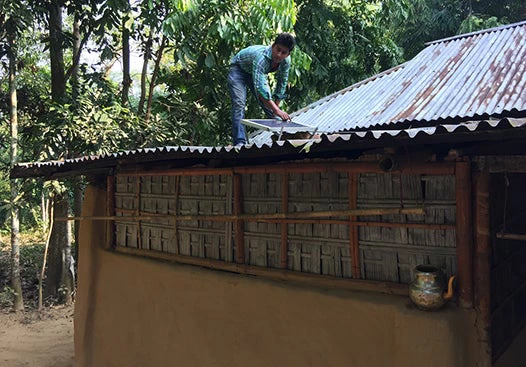
In the village of Aharkandhi in northeastern Bangladesh, life has changed since homeowners began installing solar panels on their roofs. At night, families gather at the local grocery store to watch TV, which boosts business. Children study longer than before.
This is due in part to a World Bank-financed electrification project to promote off-grid electricity in rural communities. This year, the project became the first renewable energy program in Bangladesh to be issued carbon credits for lowering greenhouse gas emissions and the world's first Programme of Activities for solar home systems under the UNFCCC’s Clean Development Mechanism (CDM) to generate carbon credits.
With access to electricity, people are finding new ways to increase their income, and the word is spreading quickly across villages.
Mujib, a shopkeeper, saw his income increase by 1,000 Tk per month (about US$13), and his evening business grew after his solar home system was installed.
After Hajra installed solar panels, she was able to power five lights so her children could study, a TV, and a mobile phone charger that allows her to keep in touch with her husband, a laborer. Previously, she used kerosene, and she remembers the fumes that filled her house.
This is one of the fastest growing renewable energy programs in the world – to date, more than 3.5 million solar home systems have been installed in rural Bangladesh, creating 70,000 direct jobs.
Bolstering financing through carbon credits
Solar power is helping to green Bangladesh’s energy mix. Renewable energy accounts for less than 1 percent of the country’s energy generation, but the government aims to have 10 percent of its national grid powered by renewable energy by 2020. Adding solar panels to rural homes is an important part of the country’s sustainable development strategy.
In addition to providing energy, the solar home systems are reducing greenhouse gas emissions and earning carbon credits by reducing the use of kerosene lamps for lighting and diesel generators that had been used to charge batteries.
The program is projected to deliver 1.1 million Certified Emission Reductions, or carbon credits, by 2016, issued under the CDM. The carbon credits are sold to the World Bank’s Community Development Carbon Fund, generating a revenue stream that is shared by the companies involved in financing, installing and servicing the solar panels to expand the program.
It is also the first solar home system Programme of Activities under the UN’s Clean Development Mechanism to generate carbon credits. As an approved Programme of Activities, it is able to combine 13 similar projects under one country-wide umbrella program, lowering transaction costs and creating the possibility to add similar projects in the future in a simplified process.
The sun provides light in rural Bangladesh
Benefits of solar panels abound. Communities are reporting a significant increase in the quality of life thanks to better, safer, and cheaper lighting and the ability to power electrical appliances, cell phones, TVs, and radios. Remote and poor families can now hear weather forecasts on the radio and watch the news on small TVs, which becomes more than just a luxury in a country that frequently faces severe weather.
Night lights are improving safety in the dark, especially for women and children. Replacing conventional kerosene lamps and their toxic fumes helps reduce indoor air pollution, fire hazards, and health risks such as respiratory diseases. And the solar panel industry is booming, including employing Bangladeshi women.
Solar panel subsidies help the poor
The solar panels are subsidized by the Infrastructure Development Company, Ltd. (IDCOL), a state-owned financial institution that provides families with grants and credits to pay for part of the cost and provide electricity in a country where only 60 percent of the population and about 42 percent of rural households haves access to electricity. Around 13 million rural households still live without power. Even those connected to the grid experience black-outs during peak hours because electricity supply can’t keep up with demand.
Installing solar panels has become a reliable and increasingly financially viable solution for more Bangladeshis. A 20 watt-peak system costs about US$150, which is paid by the users over three years and provides enough electricity to power two lights and one mobile charger. Bangladeshis even in the most rural areas rely on cell phones.
Overcoming the affordability barrier has been crucial in allowing for a widespread adoption of solar home systems. The cost of solar panels has come down over time, and today there is a growing trend for very small, 10 watt-peak panels, allowing poorer households gain access to electricity.
The Bangladesh program is one of the most successful solar home system programs in the world. It's a model that is bringing cheaper and more reliable electricity to remote areas of the country and has potential to go beyond Bangladesh to be scaled up in other developing countries.

Photos: Xiaoyu Chang/World Bank


Join the Conversation